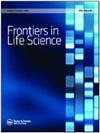核天体物理学中稀有化学元素的宇宙起源
Q1 Biochemistry, Genetics and Molecular Biology
引用次数: 5
摘要
我们所感知到的世界千变万化,但许多事物都是由大约一百种不同的化学元素组成的,其中有氢、碳、氮、氧、铁和铀。这些元素以多种方式相互结合,产生所有对象的复杂性。然而,只有三个核合成天体物理地点:(i)大爆炸核合成,在那里产生氢和氦;(ii)恒星,从碳到铀的所有元素都在那里合成;(iii)星系中的星际介质,其中锂(一部分)、铍和硼是由宇宙射线与星际物质之间的非热碰撞产生的。原子的起源现在已经很清楚了。这是20世纪最伟大的天体物理学发现之一。门捷列夫表中的所有元素,特别是生命的原子:碳、氮和氧,都来自于星系中各代恒星的工作。目前,在13.8 Gyr之后,宇宙中的原子物质由70%的氢,28%的氦和大约2%的其他元素组成。复合原子(还有一些特定的光原子)在宇宙中是罕见的。本文章由计算机程序翻译,如有差异,请以英文原文为准。
Cosmic origin of the chemical elements rarety in nuclear astrophysics
ABSTRACT We perceive a world of great diversity but numerous things are composed of about a hundred different chemical elements, among them are hydrogen, carbon, nitrogen, oxygen, iron, and uranium. These elements are combined with one another in a multitude of ways to produce complexity of all objects. However, there are only three nucleosynthetic astrophysical sites: (i) big bang nucleosynthesis, where hydrogen and helium are produced; (ii) stars, where all elements from carbon to uranium are synthesized and (iii) interstellar medium in galaxies where lithium (a part of), beryllium and boron are made by non-thermal collisions between cosmic rays and interstellar matter. The origin of the atoms is now well understood. It is one of the greatest astrophysical discovery in the twentieth century. All the elements in the Mendeleev table, and specifically the atoms of life: carbon, nitrogen and oxygen, come from the work of all generations of stars in galaxies. Presently, after 13.8 Gyr, atomic matter in the universe is composed of 70% hydrogen, 28% helium and only about 2% by mass, of all the other elements. Complex (and also some specific light) atoms are rare in the Universe.
求助全文
通过发布文献求助,成功后即可免费获取论文全文。
去求助
来源期刊

Frontiers in Life Science
MULTIDISCIPLINARY SCIENCES-
CiteScore
5.50
自引率
0.00%
发文量
0
期刊介绍:
Frontiers in Life Science publishes high quality and innovative research at the frontier of biology with an emphasis on interdisciplinary research. We particularly encourage manuscripts that lie at the interface of the life sciences and either the more quantitative sciences (including chemistry, physics, mathematics, and informatics) or the social sciences (philosophy, anthropology, sociology and epistemology). We believe that these various disciplines can all contribute to biological research and provide original insights to the most recurrent questions.
 求助内容:
求助内容: 应助结果提醒方式:
应助结果提醒方式:


